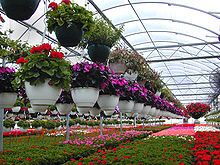Floriculture, or flower farming, is a discipline of horticulture concerned with the cultivation of flowering and ornamental plants for gardens and for floristry, comprising the floral industry. The development, via plant breeding, of new varieties is a major occupation of floriculturists.
Floriculture crops include bedding plants, flowering plants, foliage plants or houseplants, cut cultivated greens, and cut flowers. As distinguished from nursery crops, floriculture crops are generally herbaceous. Bedding and garden plants consist of young flowering plants (annuals and perennials) and vegetable plants. They are grown in cell packs (in flats or trays), in pots, or in hanging baskets, usually inside a controlled environment, and sold largely for gardens and landscaping. Geraniums, impatiens, and petunias are the best-selling bedding plants. Chrysanthemums are the major perennial garden plant in the United States.
Flowering plants are largely sold in pots for indoor use. The major flowering plants are poinsettias, orchids, florist chrysanthemums, and finished florist azaleas. Foliage plants are also sold in pots and hanging baskets for indoor and patio use, including larger specimens for office, hotel, and restaurant interiors.
Cut flowers are usually sold in bunches or as bouquets with cut foliage. The production of cut flowers is specifically known as the cut flower industry. Farming flowers and foliage employs special aspects of floriculture, such as spacing, training and pruning plants for optimal flower harvest; and post-harvest treatment such as chemical treatments, storage, preservation and packaging. In Australia and the United States some species are harvested from the wild for the cut flower market.

No comments:
Post a Comment